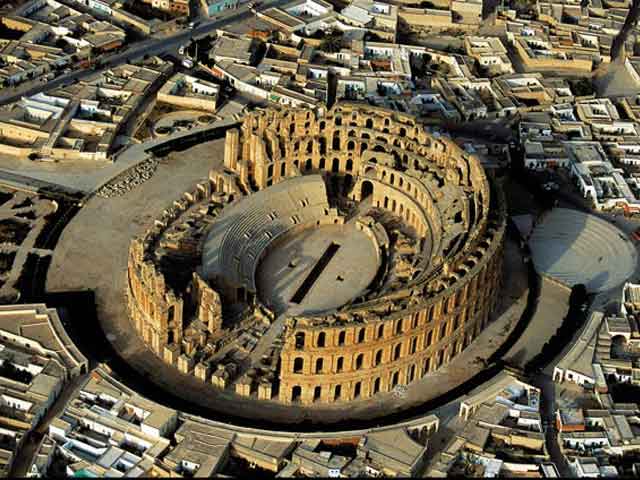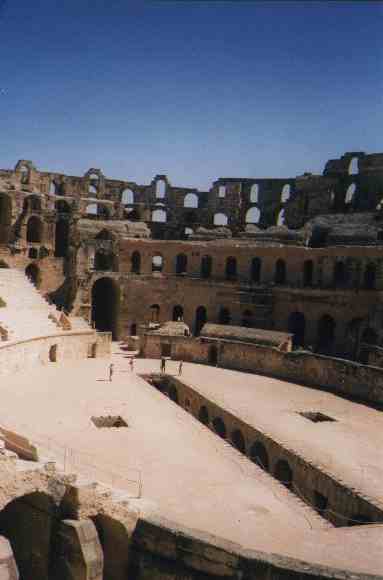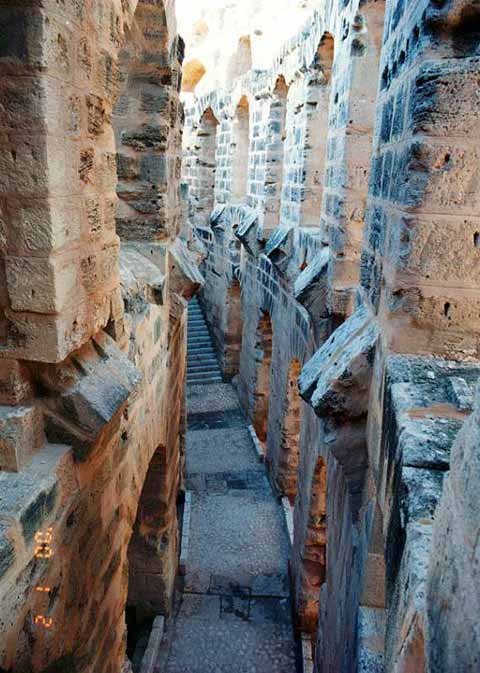Dying to Be Entertained
El-Djem, TunisiaConservatism discards Prescription, shrinks from Principle, disavows Progress; - Benjamin Disraeli
Amphitheater at El-Djem, Governorate of Mahdia, Tunisia (N 35°18'-E 10°43') Approaching El-Djem by road, one sees a vast, cylindrical, entirely mysterious structure rising up in the distance. Only as one gets closer does one discover a sleepy little town beneath it. Here the ancient world seems to overshadow the modern world completely. The amphitheater, probably dating from the beginning of the 3rd century, is famous for its size – 148 metres (485 feet) long, 124 metres (407 feet) wide, and with a perimeter of 427 metres (1,400 feet) – and its state of conservation. The ancient Roman city of Thysdrus had initially made do with an amphitheatre carved out of the soft volcanic tuff. The growth of the city’s population (probably to several tens of thousands in the 2nd to 3rd centuries) and its increase in wealth thanks to olive-growing, demanded the construction of this prestigious edifice whose architecture is similar to that of the Colosseum in Rome.
El-Djem serves as a reminder that in ancient times the population south of the Mediterranean was as large and prosperous as that to the north, and suggests that the same demographics could return without causing a catastrophe. As impressive as it is now, the El-Djem amphitheater would appear small next to skyscrapers around it. The amphitheater (often incorrectly called "a colosseum") is capable of seating 35,000 spectators. Only Rome's Colosseum (about 45,000 spectators) and the ruined theatre of Capua are larger. This amphitheater was built by the Romans under proconsul Gordian, who was acclaimed Emperor at Thysdrus, around 238 and was probably mainly used for gladiator shows and chariot races (like in Ben-Hur). It is possible that construction of the amphitheatre was never finished. Until the 17th century it remained more or less whole. From then on its stones were used for building the nearby village of El Djem and transported to the Great Mosque in Kairouan, and at a tense moment during struggles with the Ottomans, the Turks used cannons to flush rebels out of the amphitheater.
Source: asahi-net.or.jp The ruins of the amphitheatre were declared a World Heritage Site in 1979. Source: yannarthusbertrand.com, geocities.com, wikipedia.org
I don't understand why the Colosseum in Rome is several times more well-known than this ampitheatre which is in better shape and from the same era. Frankly, I like it better.
For more articles relating to Money, Politics and Law including globalisation, tax avoidance, consumerism, credit cards, spending, contracts, trust, stocks, fraud, eugenics and
more click the "Up" button below to take you to the page on "How Many Countries in the World?" Clicking "Up" from there will take you to the Index for this section. |
 Animals
Animals Animation
Animation Art of Playing Cards
Art of Playing Cards Drugs
Drugs Education
Education Environment
Environment Flying
Flying History
History Humour
Humour Immigration
Immigration Info/Tech
Info/Tech Intellectual/Entertaining
Intellectual/Entertaining Lifestyles
Lifestyles Men
Men Money/Politics/Law
Money/Politics/Law New Jersey
New Jersey Odds and Oddities
Odds and Oddities Older & Under
Older & Under Photography
Photography Prisons
Prisons Relationships
Relationships Science
Science Social/Cultural
Social/Cultural Terrorism
Terrorism Wellington
Wellington Working
Working Zero Return Investment
Zero Return Investment

